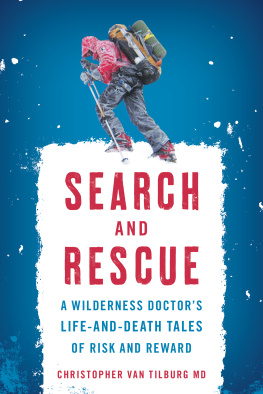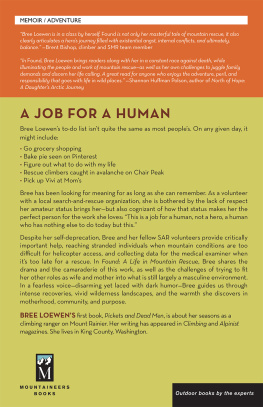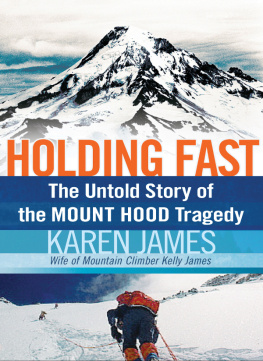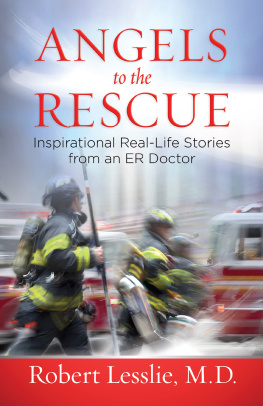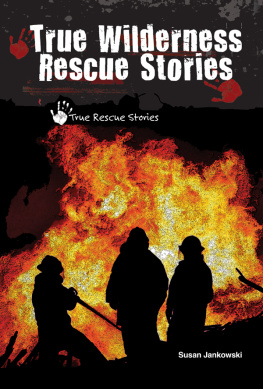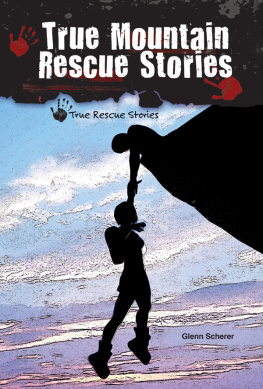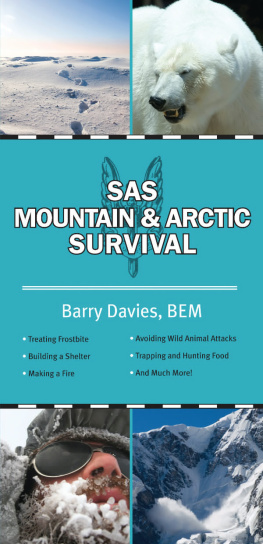MOUNTAIN RESCUE DOCTOR. Copyright 2007 by Christopher Van Tilburg. All rights reserved. Printed in the United States of America. No part of this book may be used or reproduced in any manner whatsoever without written permission except in the case of brief quotations embodied in critical articles or reviews. For information, address St. Martins Press, 175 Fifth Avenue, New York, N.Y. 10010.
www.stmartins.com
Book design by Spring Hoteling
Library of Congress Cataloging-in-Publication Data
Van Tilburg, Christopher.
Mountain rescue doctor : wilderness medicine in the extremes of nature / Christopher Van Tilburg.1st ed.
p. cm.
ISBN-13: 978-0-312-35888-7
ISBN-10: 0-312-35887-3
1. Van Tilburg, Christopher 2. Mountaineering injuriesUnited States. 3. Mountaineering accidentsUnited States. 4. Rescue workUnited States. 5. Emergency physiciansUnited StatesBiography. I. Tide.
[DNLM: 1. MountaineeringinjuriesPersonal Narratives. 2. Rescue WorkPersonal Narratives. 3. First AidPersonal Narratives. QT 260.5.M9 V216m 2007]
RC88.9.M6 V37 2007 |
616.0252dc22 | 2007028304 |
First Edition: November 2007
10 9 8 7 6 5 4 3 2 1
M OUNTAIN R ESCUE D OCTOR
A LSO BY C HRISTOPHER V AN T ILBURG, M.D.
Introducing Your Kids to the Outdoors
Watersports Safety and Emergency First Aid: A Handbook for Boaters,
Anglers, Kayakers, River Runners, and Surfriders
Emergency Survival: A Pocket Guide
First Aid: A Pocket Guide (Editor)
Backcountry Ski! Oregon: Classic Descents for Skiers and Snowboarders,
Including Southwest Washington
Canyoneering: Beginning to Advanced Techniques
Backcountry Snowboarding
A UTHORS N OTE
T his is a work of nonfiction, but identifying characteristics of certain people, places, and times have been changed. The names of all living patients have been changed. The dialogue and actual facts of rescues are based on my recollections and my notes taken afterward. Considering the tension involved in a mountain search and rescue mission, the descriptions are as accurate as possible. The rescues occurred during the many years that I have participated in mountain rescue and worked at the mountain clinic. Although I relied on many sources writing this book, the bulk content of these tales came from my brain, and thus is subject to the limitation of my human mind.
I thank colleagues and friends who commented critically on the manuscript: Craig Danner, Mark Nykanen, Andrew McElderry, and Crag Rats Jay Sherrerd, Dave Wagg, and Paul Crowley. Joelle Delbourgo has been a believer ever since my one-sentence e-mail about the project years ago. John Paine lent a keen eye to the words. Nichole Argyres at St. Martins shaped this manuscript expertly and enthusiastically. Getting this book to press required the effort of a team, to which I owe thanks: Kylah McNeill and David Stanford Burr at St. Martins, copyeditor Martha Schwartz, and Kevin Goering.
I thank my parents, Wayne and Eleanor Van Tilburg, for immeasurable support for my doctoring and writing endeavors, and my siblings, Jennifer Sato, Suzy Rylander, Peter Van Tilburg, and Joanne Guralnick, who provided incalculable and intangible support during the December 2006 Mount Hood search.
I recognize my daughters, Skylar and Avrie, for their help with rescue call outs and for their deep concern for those injured and for the families of those who did not return from the mountain.
I admire and am grateful for every member of the Crag Rats and the search and rescue community across the globe, who save lives and make the beautiful wilderness of our world a safer place.
C HRISTOPHER V AN T ILBURG ,
Cloud Cap Inn,
Mount Hood
SPRING
C HAPTER 1
Resuscitation
B elay on? I shout.
On belay, yells Jim.
Send me down! I holler back as Jim begins to lower me into the crack in the earth. I cant see much. Not the bottom of the canyon. Not the cliff. Not the nearly dead patient lying on a ledge halfway to the creek. The hillside is thickly tangled with vine maple, ferns, and poison oak. I drop backward in a blind descent on the rope and plow through the brush with my butt and back. A branch catches my helmet and twists my neck. I duck my head to release the branch, which snaps back and pops me again in the face. My boots squelch into the thick muck and leave deep footprints. When I hit soft forest duff, the thickly matted decaying leaves and branches of the forest floor, my feet slip. My knees slam the ground with a sickening thud. Pain shoots into my legs. I hope I didnt break my kneecaps. I start to slide on my knees. The rope holds fast.
As Jim lowers me into the abyss, I also have to haul down the stretcher and medical bag, as the brush is too thick and entangled to drop the gear down on a rope. So in addition to keeping myself upright, bushwhacking backward down the hillside, and trying to watch for the upcoming cliff edge, I am dragging the stretcher. Wiry vine maple branches reach out, grab the stretcher, and pull it back up the hill. As I tug, the vine maple fights back and tears my shirt. Finally I yank the stretcher with all my might. It pops free, slides another ten feet, and nearly bowls me over. The rope goes taut again: Jims got me.
I am worried. I am dangling on a rope on the edge of a cliff, descending into a remote, rugged canyon in the mountain wilderness. I have the utmost trust in my partner, fellow mountain rescuer Jim Wells, climber and orchardist. When the rescue page goes out, Jim is always among the first to respond. He has me locked securely on the rope. I trust him with my lifeno second thoughts. What Im worried about is the patient, who looks from my vantage point, to be very near death. Earlier, from high on the trail, we spied him through a thin fissure in the rock. She was perilously balanced on a small rocky ledge near the bottom of the cliff but far from the floor of the canyon. Blood was spattered on the rocks. She was not moving.
If that isnt enough, Jim and I are acutely troubled by the four peopletwo volunteer firefighters and two hikerswho are with the woman on the ledge. The two hikers heard cries for help and the two firefighters from the closest town, Cascade Locks, hiked down an old deer trail to the scene. The mantra of mountain rescue is in the forefront of my mind: no one else gets hurt. Even before rescuing an injured person, protection of the rescuers always comes first. A rescuer does no good, and puts many at risk, if he or she becomes injured. Our own safety is most important: if we cant reach an injured person safely, we wont. Second, protect the team. Third, rescue the patient. The safety of the team is part of Jims responsibility as incident commander and mine as a member of the rescue team. I am anxious to drop over the cliff and get to the ledge but need to do so safely.
H ood River County, Oregon, is sprawling, rural, and rugged. Forty miles from the town of Hood River at the south end of the county, lies Mount Hoodthe 11,239-foot-high, perennially snowcapped, active volcano that dominates the landscape. The mountain lies in the Mount Hood Wilderness, a subsection of the Mount Hood National Forest. The land is populated by old- and second-growth mixed conifer forests. The patriarchal Douglas fir intermingles with noble fir, white pine, western red cedar, mountain hemlock, and western hemlock. The rich green understory is thick and lush with vine maple, sword ferns, thin-leaf huckleberry, Oregon grape, salal,rhododendron, kinnikinnick, and vanilla leaf.
To the north, adjacent to the town of Hood River, lies the great Columbia River. The 1,243-mile-long stream originates in Canada and spews into the Pacific Ocean. The river slices through the Cascade Mountains and flows west past Hood River County. Near the town of Hood River, the river meanders through a deep gorge marked by 4,000-foot-high cliffs, waterfalls, rock pinnacles, deep gullies, narrow canyons, lava beds, and volcanic cinder cones. This area is so beautiful that Congress created the Columbia River Gorge National Scenic Area: a section of land in northern Oregon and southern Washington that begins in the outskirts of Portland and stretches 90 miles east.
Next page

